Comparative Study of the Dynamic Deformation of Pure Molybdenum at High Strain Rates and High Temperatures
Abstract
1. Introduction
2. Materials and Experimental Procedures
2.1. Test Material
2.2. Experimental Method
3. Experimental Results and Discussion
Metallographic Examination
4. Mechanical Property Evaluation
4.1. Stress–Strain Relationship
4.2. Sensitivity to the Strain Rate
4.3. Sensitivity to Strain
4.4. Sensitivity to Temperature
4.5. Modified Johnson–Cook Constitutive Model
4.6. Rate-Temperature Equivalence
4.7. Temperature Modified Flow Stress
4.8. Impact Embrittlement and Toughening
5. Conclusions
Author Contributions
Funding
Institutional Review Board Statement
Informed Consent Statement
Data Availability Statement
Conflicts of Interest
References
- Burghardt, J.; Leavy, B.; Guilkey, J.; Xue, Z.; Brannon, R. Application of Uintah-MPM to shaped charge jet penetration of aluminum. IOP Conf. Ser. Mater. Sci. Eng. 2010, 10, 012223. [Google Scholar] [CrossRef]
- Cowan, K.; Bourne, B. Analytical code and hydrocode modelling and experimental characterisation of shaped charges containing conical molybdenum liners. In Proceedings of the 19th International Ballistic Symposium, Interlaken, Switzerland, 7–11 May 2001. [Google Scholar]
- Sable, P.; Helminiak, N.S.; Gullerud, A.; Harstad, E.; Hollenshead, J.; Hertel, E.S. Characterizing In-Flight Temperature of Shaped Charge Penetrators in CTH. In HVIS, Proceedings of the 14th Hypervelocity Impact Symposium, Canterbury, UK, 24–28 April 2017; Elsevier Ltd.: Amsterdam, The Netherlands, 2017; Volume 204, pp. 375–382. [Google Scholar]
- Stewart, B.; Ian, L. Integration of an Over-Fly Top Attack Shaped Charge Jet within a Kinetic Energy Penetrator for Enhanced Multiple-Effects. In Proceedings of the 30th International Symposium on Ballistics, Long Beach, CA, USA, 11–15 September 2017. [Google Scholar]
- Voumard, C.; Roduner, H.-P.; Santschi, W.; Wister, H. Performances and behaviour of wcu-pseudo-alloy shaped charges with a simple model for calculating the stand-off curve. In Proceedings of the 19th International Symposium on Ballistics, Interlaken, Switzerland, 7–11 May 2001. [Google Scholar]
- Daniels, A.S.; Baker, E.L.; Vuong, T.H.; Chin, C.L.; Fuchs, B.F.; DeFisher, S.E. Selectable initiation shaped charges. In Proceedings of the 20th International Symposium on Ballistics, Orlando, FL, USA, 23–27 September 2002; DEStech Publications Inc.: Lancaster, PA, USA, 2002; pp. 589–596. [Google Scholar]
- Yuan, N.; Jianwei, J.; Shuyou, W.; Han, L. Experimental Research on the Influence of ERA on Penetration Efficiency of EFP. Acta Armamentarii 2018, 39, 1576–1581. [Google Scholar]
- Hancock, S.; Ouye, N.; Boeka, D. Effects of Jet Particulation and Velocity on the Energy/Volume Ratio in RHA. In Proceedings of the 21th International Symposium on Ballistics, Adelaide, SA, Australia, 19–23 April 2004. [Google Scholar]
- Mickovi, D.; Jaramaz, S.; Elek, P.; Miloradović, N.; Jaramaz, D. A Model for Explosive Reactive Armor Interaction with Shaped Charge Jet. Propellants Explos. Pyrotech. 2016, 41, 53–61. [Google Scholar] [CrossRef]
- Shuai, C.; Wei-Bing, L.; Xiao-Ming, W.; Wen-jin, Y. Penetration research of dual-mode penetrator formed by shaped charge with wave shaper. Procedia Eng. 2017, 173, 57–64. [Google Scholar] [CrossRef]
- Zygmunt, B.; Wilk, Z. Formation of jets by shaped charges with metal powder liners. Propellants Explos. Pyrotech. Int. J. Deal. Sci. Technol. Asp. Energ. Mater. 2008, 33, 482–487. [Google Scholar] [CrossRef]
- Wang, F.; Jiang, J.; Men, J.; Bai, Y.; Wang, S.; Li, M. Investigation on shaped charge jet density gradient for metal matrix composites: Experimental design and execution. Int. J. Impact Eng. 2017, 109, 311–320. [Google Scholar] [CrossRef]
- Zhanlei, W.; Huiping, W.; Zhonghua, H.; Hongyu, X.; Yifan, L. Dynamic consolidation of W-Cu nano-alloy and its performance as liner materials. Rare Met. Mater. Eng. 2014, 43, 1051–1055. [Google Scholar] [CrossRef]
- Ding, L.; Jiang, J.; Men, J.; Wang, S.; Li, M. Research on feasibility of several high density materials for EFP liner and material selection criteria. Propellants Explos. Pyrotech. 2017, 42, 360–369. [Google Scholar] [CrossRef]
- Borkowski, J.; Wilk, Z.; Koslik, P.; Szymanczyk, L.; Zygmunt, B. Application of sintered liners for explosively formed projectile charges. Int. J. Impact Eng. 2018, 118, 91–97. [Google Scholar] [CrossRef]
- Duan, N.; Gao, Y.; Wang, J.; Du, W.; Wang, F. The properties of the sintered copper powder liner. J. Wuhan Univ. Technol. Mater. Sci. Ed. 2014, 29, 269–272. [Google Scholar] [CrossRef]
- Guo, W.; Liu, J.; Xiao, Y.; Li, S.; Zhao, Z.; Cao, J. Comparison of penetration performance and penetration mechanism of w-cu shaped charge liner against three kinds of target: Pure copper, carbon steel and Ti-6Al-4V alloy. Int. J. Refract. Met. Hard Mater. 2016, 60, 147–153. [Google Scholar] [CrossRef]
- Elshenawy, T. Density effect of the compacted copper-tungsten shaped charge powder liners on its penetration performance. J. Powder Metall. Min. 2017, 6, 1–6. [Google Scholar]
- Held, M. Liners for shaped charges. J. Battlef. Technol. 2001, 4, 1–7. [Google Scholar]
- Microstructure and Properties of Hot-Rolled 2.0 wt.% MoSi2/Rare Earth Oxide Doped Molybdenum Alloys—ScienceDirect. Available online: https://www.sciencedirect.com/science/article/pii/S0263436811001892 (accessed on 7 June 2021).
- Cockeram, B.V. Measuring the fracture toughness of molybdenum-0.5 pct titanium-0.1 pct zirconium and oxide dispersion-strengthened molybdenum alloys using standard and subsized bend specimens. Metall. Mater. Trans. A 2002, 33, 3685–3707. [Google Scholar] [CrossRef]
- Arnold, W.; Hartmann, T.; Rottenkolber, E. Effect of HE Grain Size on Shaped Charge Jets. In Proceedings of the 31st International Symposium on Ballistics, Hyderabad, India, 4–8 November 2019. [Google Scholar]
- Daniels, A.S.; Baker, E.L.; Ng, K.W. High Performance Trumpet Lined Shaped Charge Technology; US Army Armament Research Development and Engineering Center: Picatinny, NJ, USA, 2004. [Google Scholar]
- Ouye, N.; Boeka, D.; Hancock, S. Material Strength Effects on Shaped Charge Tip Velocities. In Proceedings of the 23th International Symposium on Ballistics, Tarragona, Spain, 16–20 April 2007; pp. 215–222. [Google Scholar]
- Hirsch, E.; Mayseless, M. The Maximum Mach Number of Coherent Copper Jet. In Proceedings of the 23th International Symposium on Ballistics, Tarragona, Spain, 16–20 April 2007; pp. 119–126. [Google Scholar]
- Xu, W.; Wang, C.; Yuan, J.; Deng, T. Bore-center annular shaped charges with different liner materials penetrating into steel targets. Def. Technol. 2019, 15, 796–801. [Google Scholar] [CrossRef]
- He, H.; Wang, L.; Shao, J.; Gao, H.; Li, F. Numerical Simulation and Experimental Study for Formation of Rod-type Jet by Molybdenum Shaped Charge Liner. Explos. Shock. Waves 2013, 33, 28–33. [Google Scholar]
- Baker, E.L.; Daniels, A.; Pham, J. Jet Break-Up Characterization of Molybdenum Shaped Charge Liners; US Army, Armament Research, Development and Engineering Center: Picatinny, NJ, USA, 2003. [Google Scholar]
- Song, P.; Li, W.-B.; Zheng, Y.; Song, J.P.; Jiang, X.C.; Yan, B.Y. Study on Plastic Deformation Behavior of Mo-10Ta under Ultra-High Strain Rate. Met. Multidiscip. Digit. Publ. Inst. 2020, 10, 1153. [Google Scholar] [CrossRef]
- Kumar, P.; Davinci, M.A.; Aashranth, B.; Vaibhaw, K.; Samantaray, D.; Borah, U.; Ratnakar, C.; Srivastava, D.; Bhaduri, A.K. Investigation on Low-Temperature Deformation Behaviour of Molybdenum Under Compressive Loading. Trans. Indian Inst. Met. 2019, 72, 1489–1492. [Google Scholar] [CrossRef]
- Tseplyaev, V.; Serenko, N.; Starikov, S. The Investigation of Dislocation Behaviour in Molybdenum Using Molecular Dynamics. In Defect and Diffusion Forum; Trans Tech Publ: Zürich, Switzerland, 2017; Volume 375, pp. 175–181. [Google Scholar]
- Walde, T. Plastic anisotropy of thin molybdenum sheets. Int. J. Refract. Met. Hard Mater. 2008, 26, 396–403. [Google Scholar] [CrossRef]
- Nemat-Nasser, S.; Guo, W.; Liu, M. Experimentally-based micromechanical modeling of dynamic response of molybdenum. Scr. Mater. 1999, 40, 859–872. [Google Scholar] [CrossRef]
- Cheng, J.; Nemat-Nasser, S.; Guo, W. A unified constitutive model for strain-rate and temperature dependent behavior of molybdenum. Mech. Mater. 2001, 33, 603–616. [Google Scholar] [CrossRef]
- Chen, S.R.; Maudlin, P.J.; Gray, G.T.I. Mechanical Properties and Constitutive Relations for Molybdenum under High-Rate Deformation; Office of Scientific and Technical Information; Technical Report; Los Alamos National Lab.: Los Alamos, NM, USA, 1998; LA-UR-98-1870. [Google Scholar]
- Meng, B.; Wan, M.; Wu, X.; Zhou, Y.; Chang, C. Constitutive modeling for high-temperature tensile deformation behavior of pure molybdenum considering strain effects. Int. J. Refract. Met. Hard Mater. 2014, 45, 41–47. [Google Scholar] [CrossRef]
- Škoro, G.P.; Bennett, J.R.J.; Edgecock, T.R.; Booth, C.N. Yield strength of molybdenum, tantalum and tungsten at high strain rates and very high temperatures. J. Nucl. Mater. 2012, 426, 45–51. [Google Scholar] [CrossRef]
- Miller, G.H.; Ahrens, T.J.; Stolper, E.M. The equation of state of molybdenum at 1400 C. J. Appl. Phys. 1988, 63, 4469–4475. [Google Scholar] [CrossRef][Green Version]
- Duffy, T.S.; Ahrens, T.J. Dynamic response of molybdenum shock compressed at 1400 C. J. Appl. Phys. 1994, 76, 835–842. [Google Scholar] [CrossRef]
- Litasov, K.D.; Dorogokupets, P.I.; Ohtani, E.; Fei, Y.; Shatskiy, A.; Sharygin, I.S.; Gavryushkin, P.N.; Rashchenko, S.V.; Seryotkin, Y.V.; Higo, Y.; et al. Thermal equation of state and thermodynamic properties of molybdenum at high pressures. J. Appl. Phys. 2013, 113, 093507. [Google Scholar] [CrossRef]
- Winter, J.M.; Bruchey William, J.; Wells, J.M.; Rupert, N.L. Review of Available Models for 3-D Impact Damage and the Potential for Incorporation of Xct Results. In Proceedings of the 21th International Symposium on Ballistics, Adelaide, SA, Australia, 19–23 April 2004. [Google Scholar]
- Braun, J.; Kaserer, L.; Stajkovic, J.; Leitz, K.-H.; Tabernig, B.; Singer, P.; Leibenguth, P.; Gspan, C.; Kestler, H.; Leichtfried, G. Molybdenum and tungsten manufactured by selective laser melting: Analysis of defect structure and solidification mechanisms. Int. J. Refract. Met. Hard Mater. 2019, 84, 104999. [Google Scholar] [CrossRef]
- Baker, E.; Daniels, A.; Voorhis, G.; Vuong, T.; Pearson, J. Development of molybdenum shaped charge liners. In Proceedings of the 127 th Annual Meeting and Exhibition of The Minerals, Metals & Materials Society, San Antonio, TX, USA, 16–19 February 1998; pp. 173–182. [Google Scholar]
- Li, Y.; Guo, Y.; Hu, H.; Wei, Q. A critical assessment of high-temperature dynamic mechanical testing of metals. Int. J. Impact Eng. 2009, 36, 177–184. [Google Scholar] [CrossRef]
- Chen, W.W.; Song, B. Split Hopkinson (Kolsky) Bar: Design, Testing and Applications; Springer Science & Business Media: Berlin/Heidelberg, Germany, 2010. [Google Scholar]
- Kajberg, J.; Sundin, K.-G. Material characterisation using high-temperature Split Hopkinson pressure bar. J. Mater. Process. Technol. 2013, 213, 522–531. [Google Scholar] [CrossRef]
- Zhang, C.; Suo, T.; Tan, W.; Zhang, X.; Liu, J.; Wang, C.; Li, Y. An experimental method for determination of dynamic mechanical behavior of materials at high temperatures. Int. J. Impact Eng. 2017, 102, 27–35. [Google Scholar] [CrossRef]
- Lindholm, U. Some experiments with the split hopkinson pressure bar. J. Mech. Phys. Solids 1964, 12, 317–335. [Google Scholar] [CrossRef]
- Johnson, G.R. A constitutive model and data for materials subjected to large strains, high strain rates, and high temperatures. In Proceedings of the 7th International Symposium on Ballistics, The Hague, The Netherlands, 19–21 April 1983; pp. 541–547. [Google Scholar]
- Johnson, G.R.; Cook, W.H. Fracture characteristics of three metals subjected to various strains, strain rates, temperatures and pressures. Eng. Fract. Mech. 1985, 21, 31–48. [Google Scholar] [CrossRef]
- Vohringer, O. Deformation Behavior of Metallic Materials; Chiem, C.Y., Ed.; Nantes ENSM: Nantes, France, 1989; p. 7. [Google Scholar]
- Lindholm, U.S. Some experiments in dynamic plasticity under combined stress. In Mechanical Behavior of Materials Under Dynamic Loads; Springer: Berlin/Heidelberg, Germany, 1968; pp. 77–95. [Google Scholar]
- Campbell, J.; Ferguson, W. The temperature and strain-rate dependence of the shear strength of mild steel. Philos. Mag. Taylor Fr. 1970, 21, 63–82. [Google Scholar] [CrossRef]
- Ma, Y.; Zhao, F.; He, J.; Wang, J. Correction of Flow Stress for Hot Compression of INCO718 Alloy. In Proceedings of the 2015 6th International Conference on Manufacturing Science and Engineering, Guangzhou, China, 28–29 November 2015; Atlantis Press: Guangzhou, China, 2015. [Google Scholar]
- Goetz, R.; Semiatin, S. The adiabatic correction factor for deformation heating during the uniaxial compression test. J. Mater. Eng. Perform. 2001, 10, 710–717. [Google Scholar] [CrossRef]
- Choudhury, A.; Brooks, C. Contributions to the heat capacity of solid molybdenum in the range 300–2890 K. Int. J. Thermophys. 1984, 5, 403–429. [Google Scholar] [CrossRef]


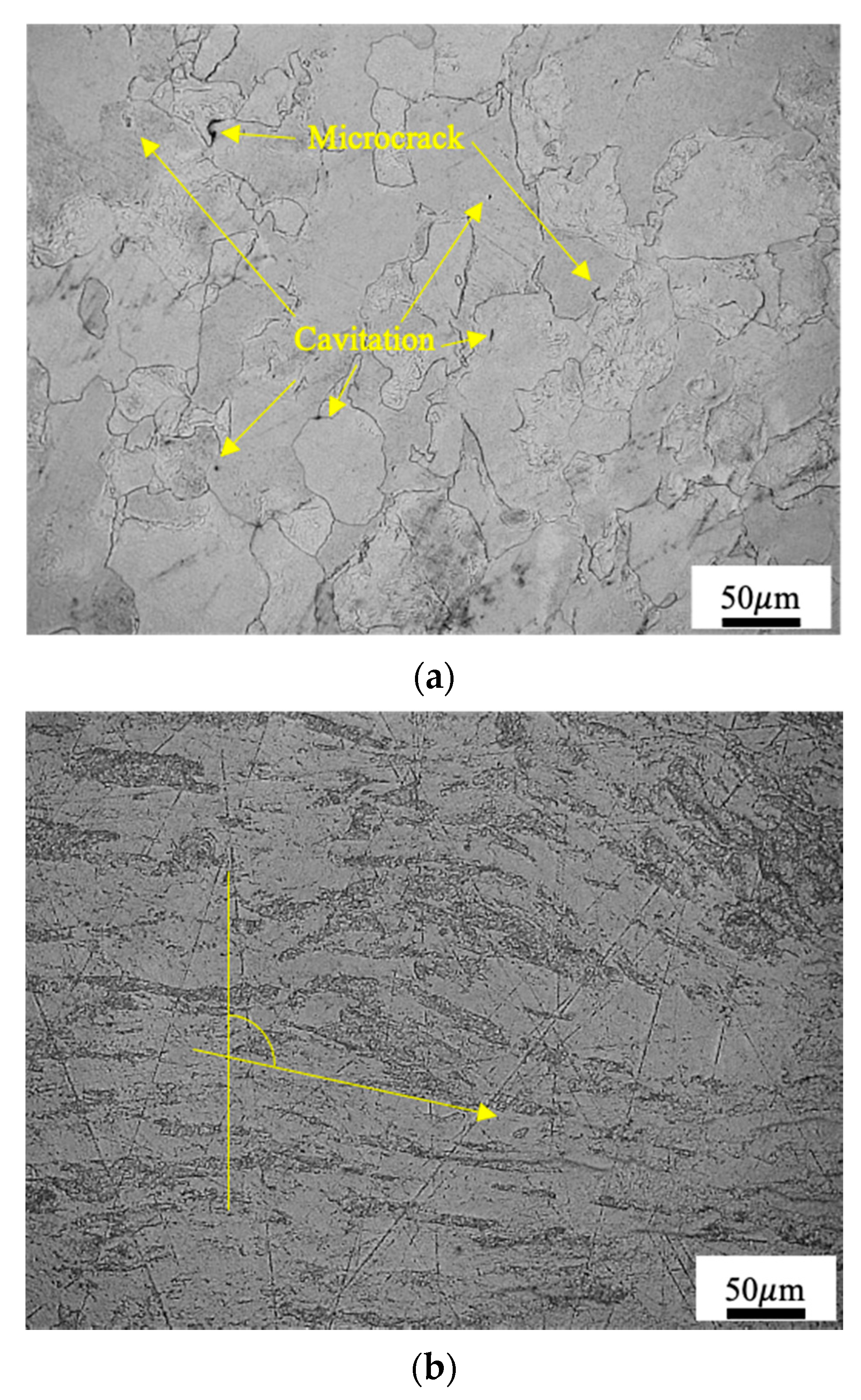
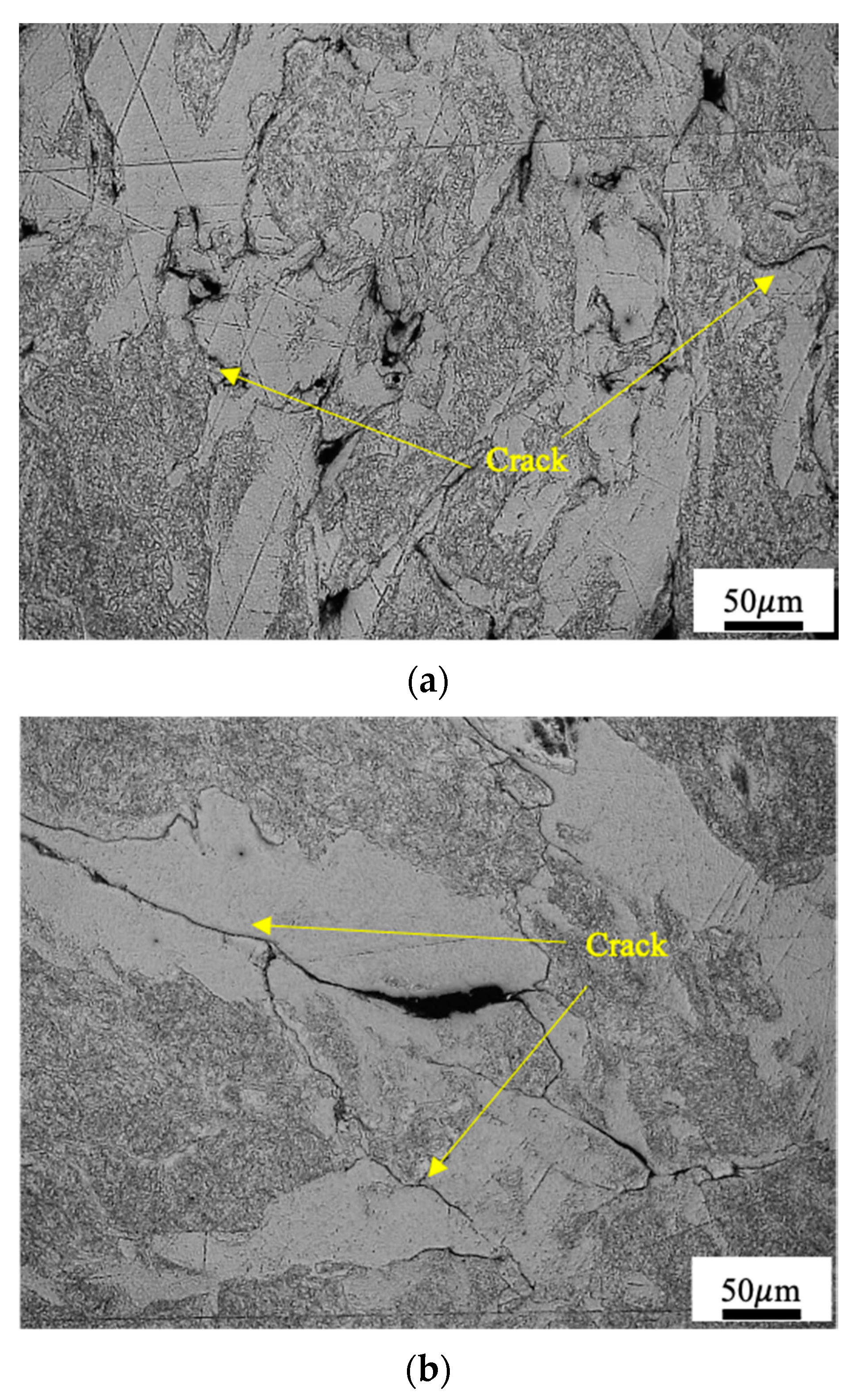

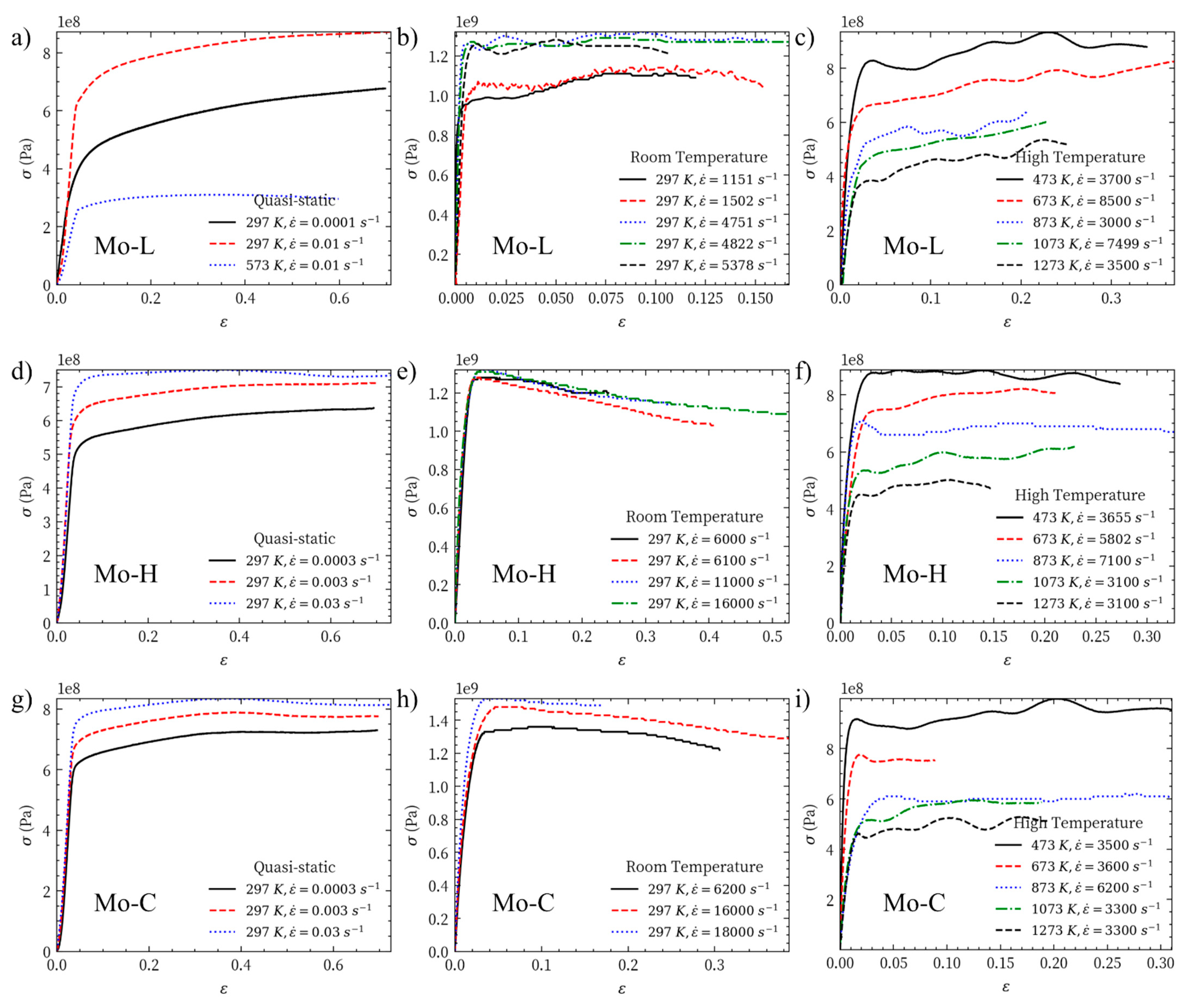
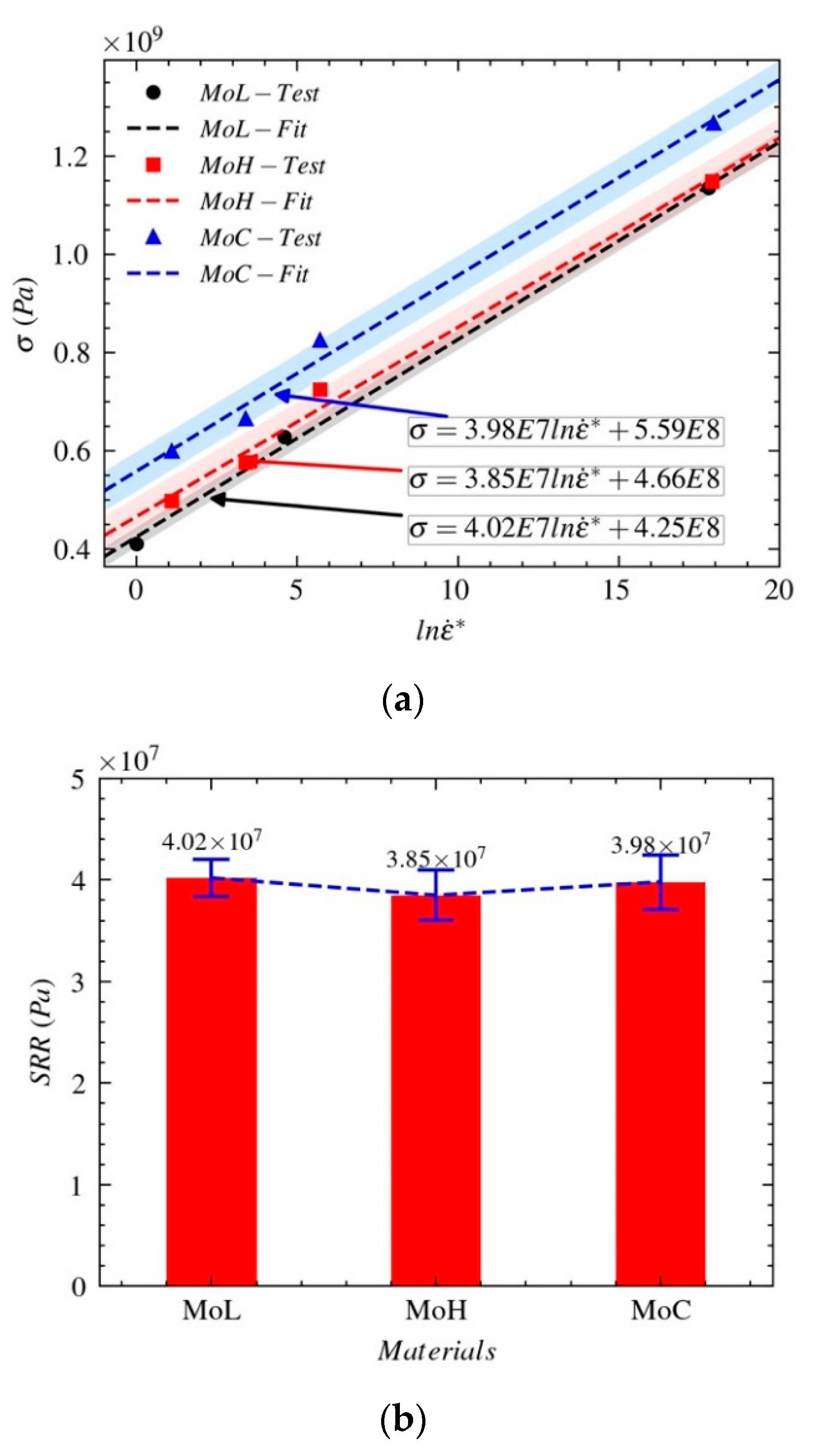
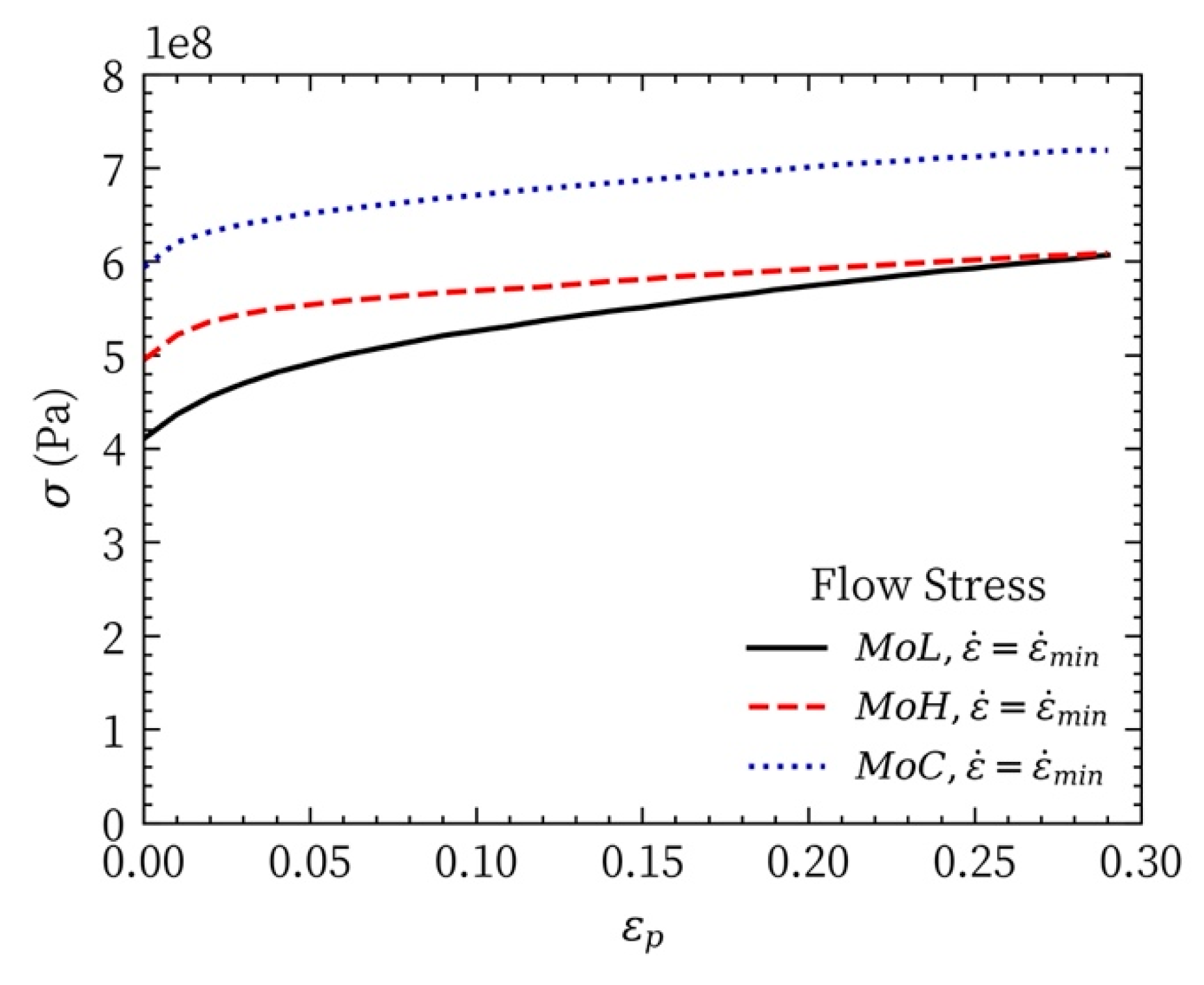
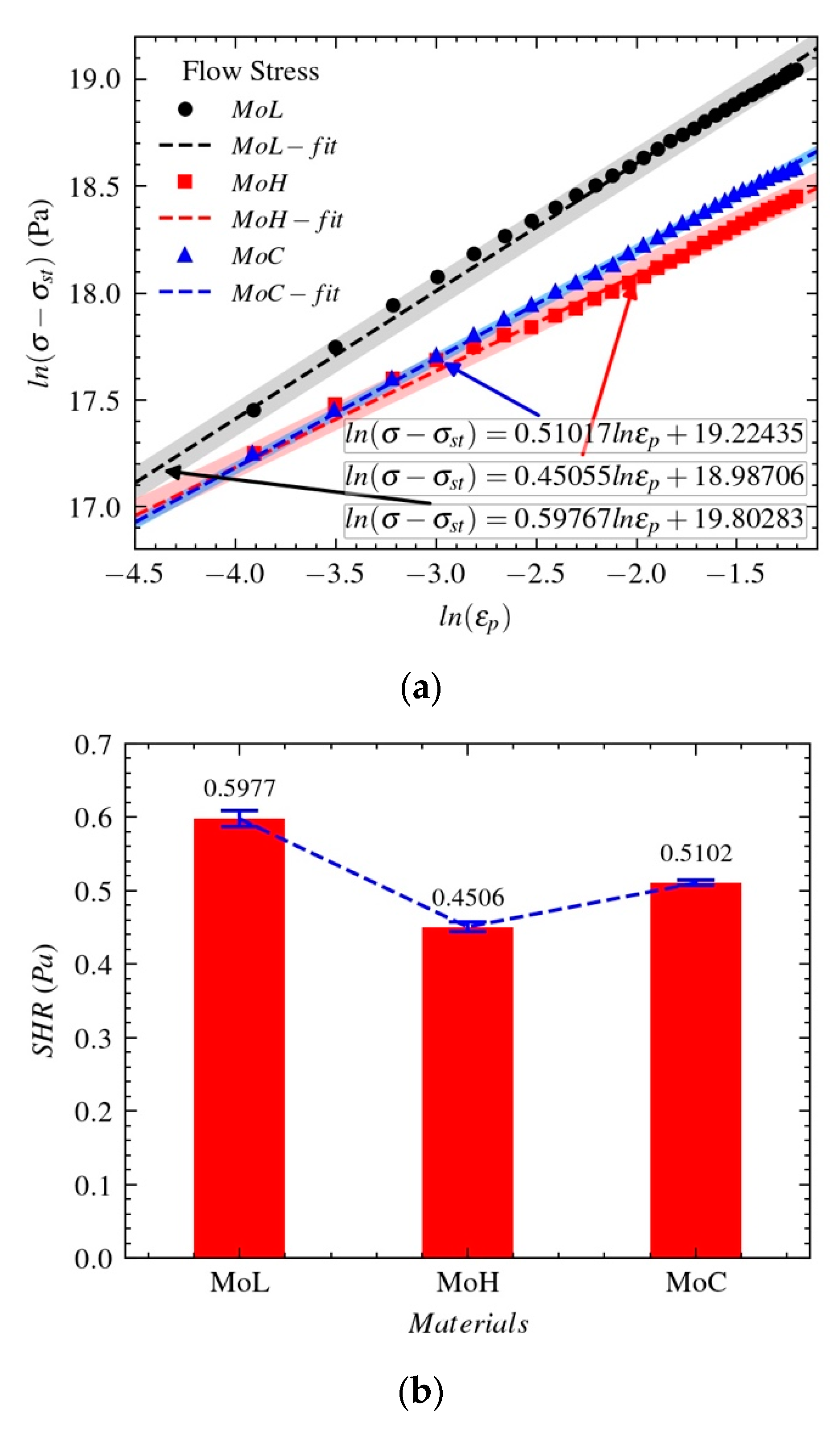
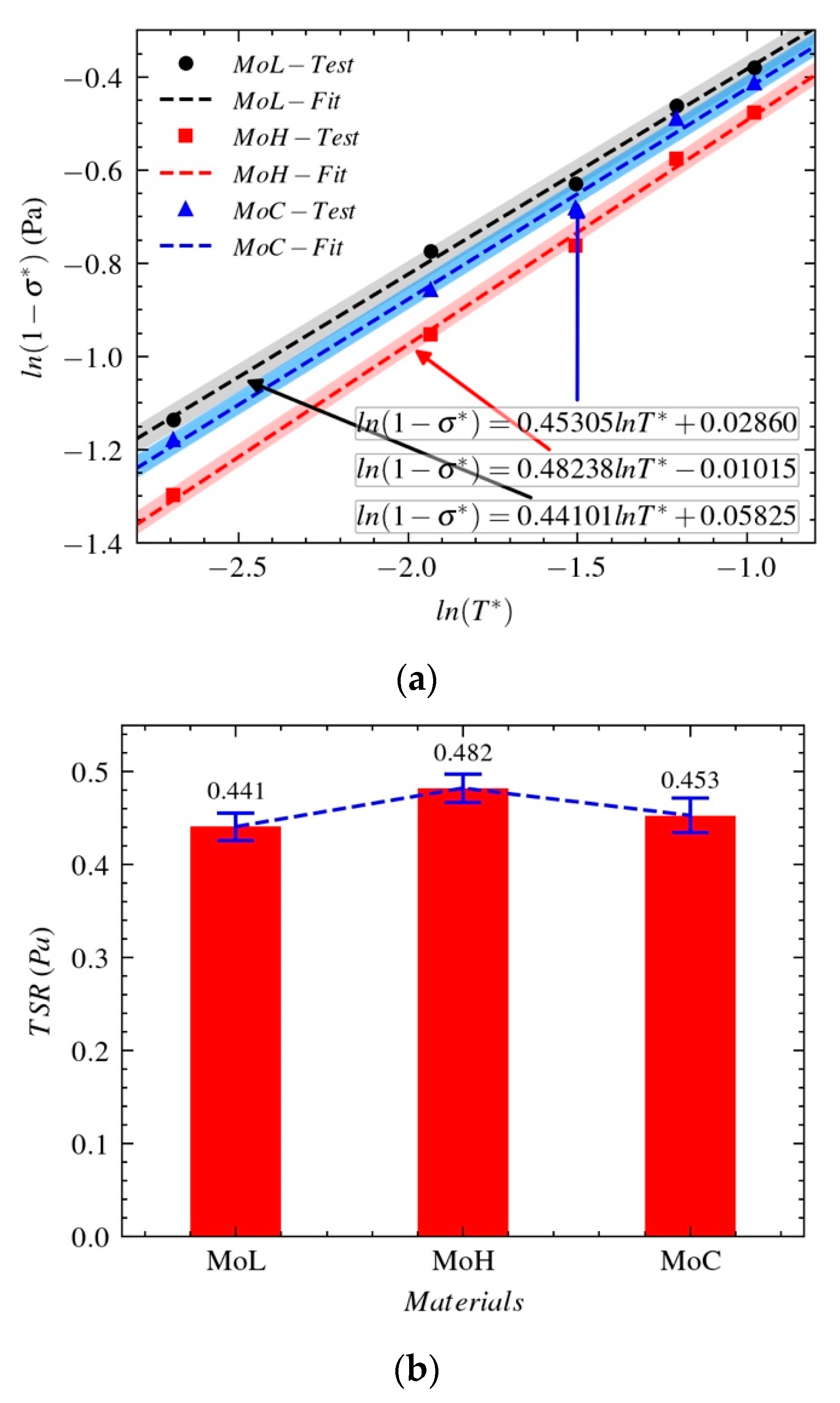
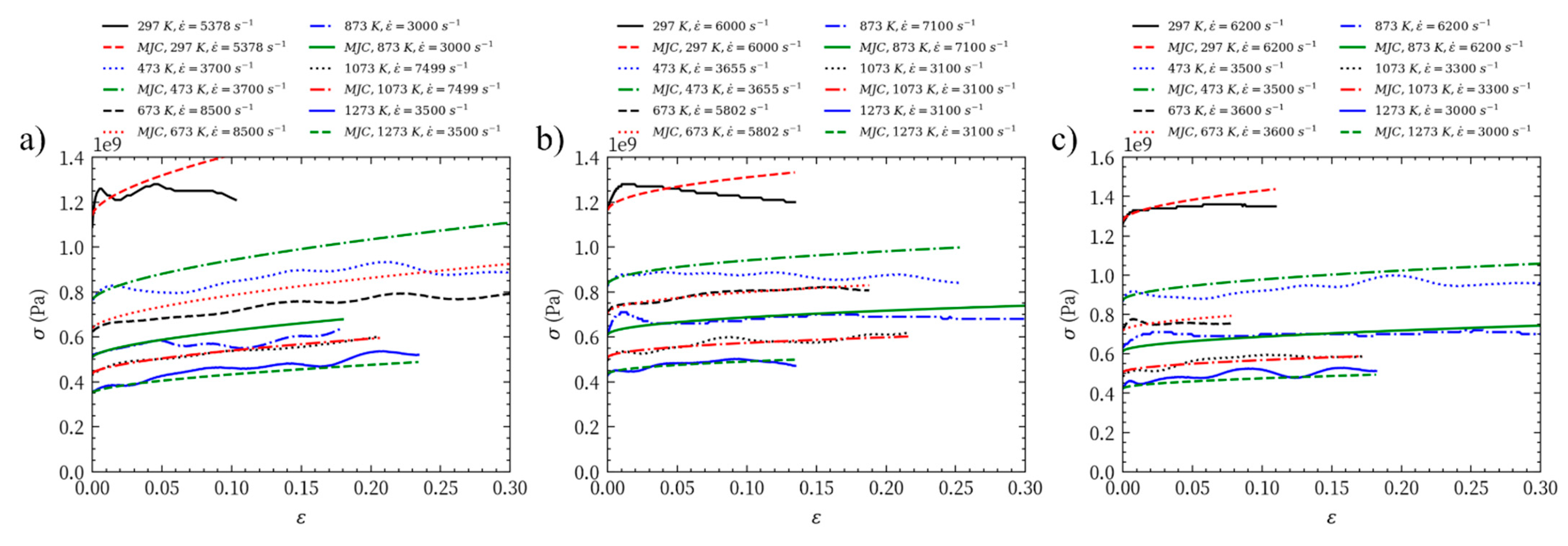
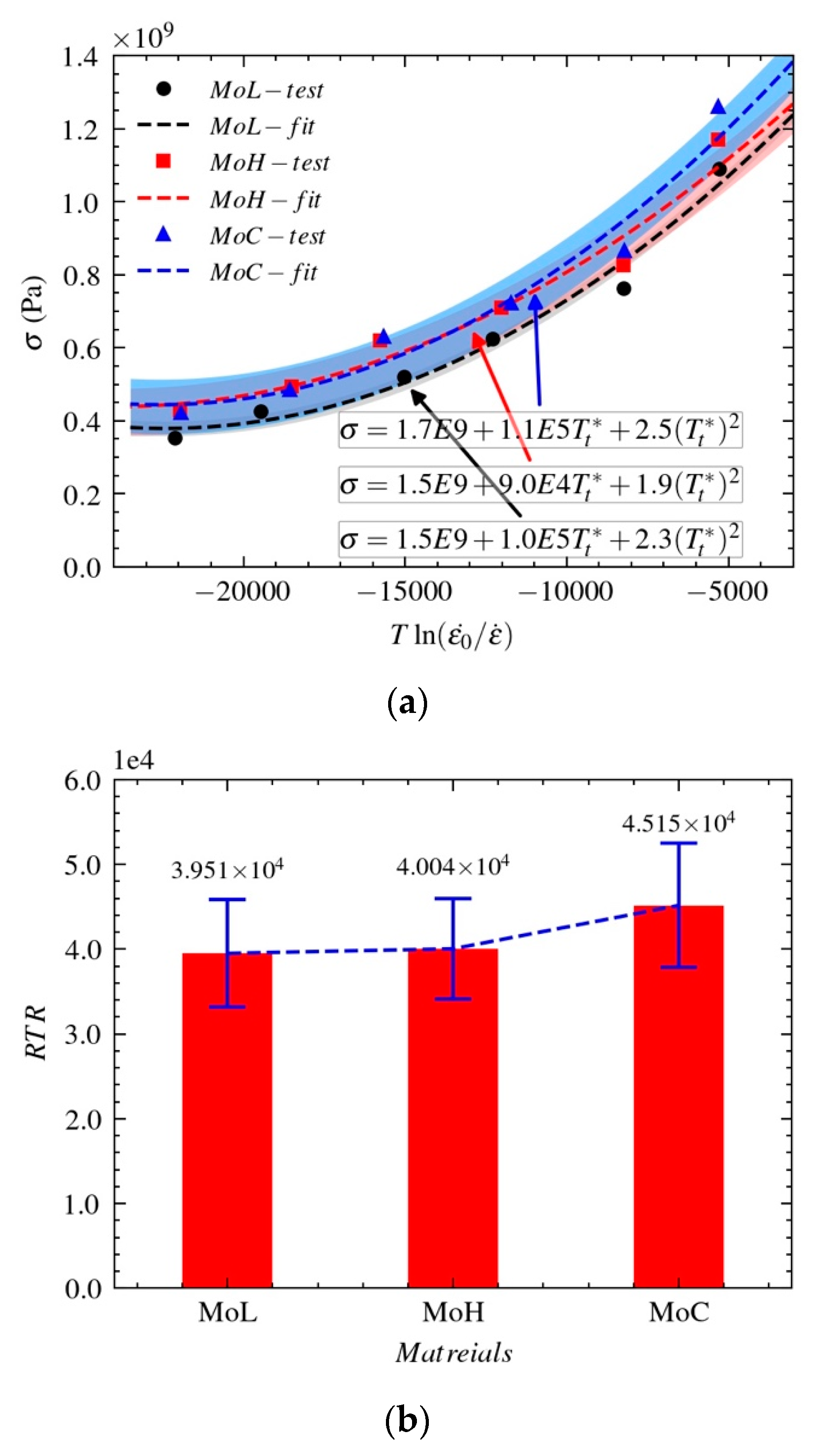

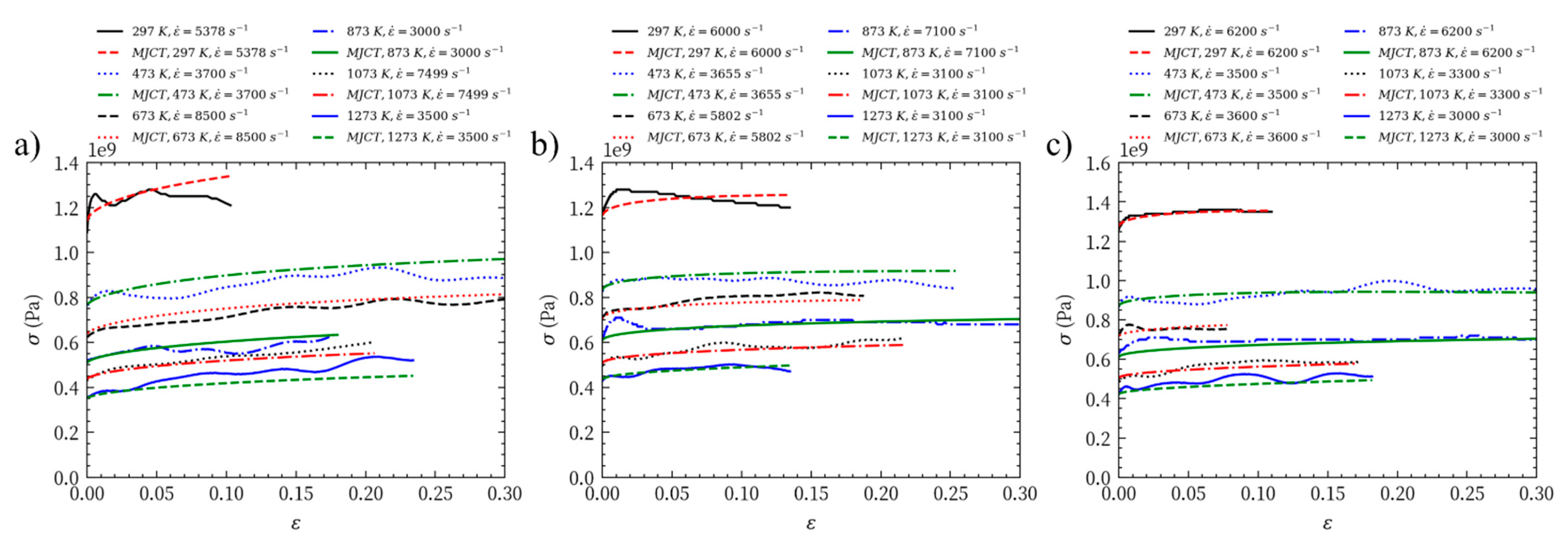
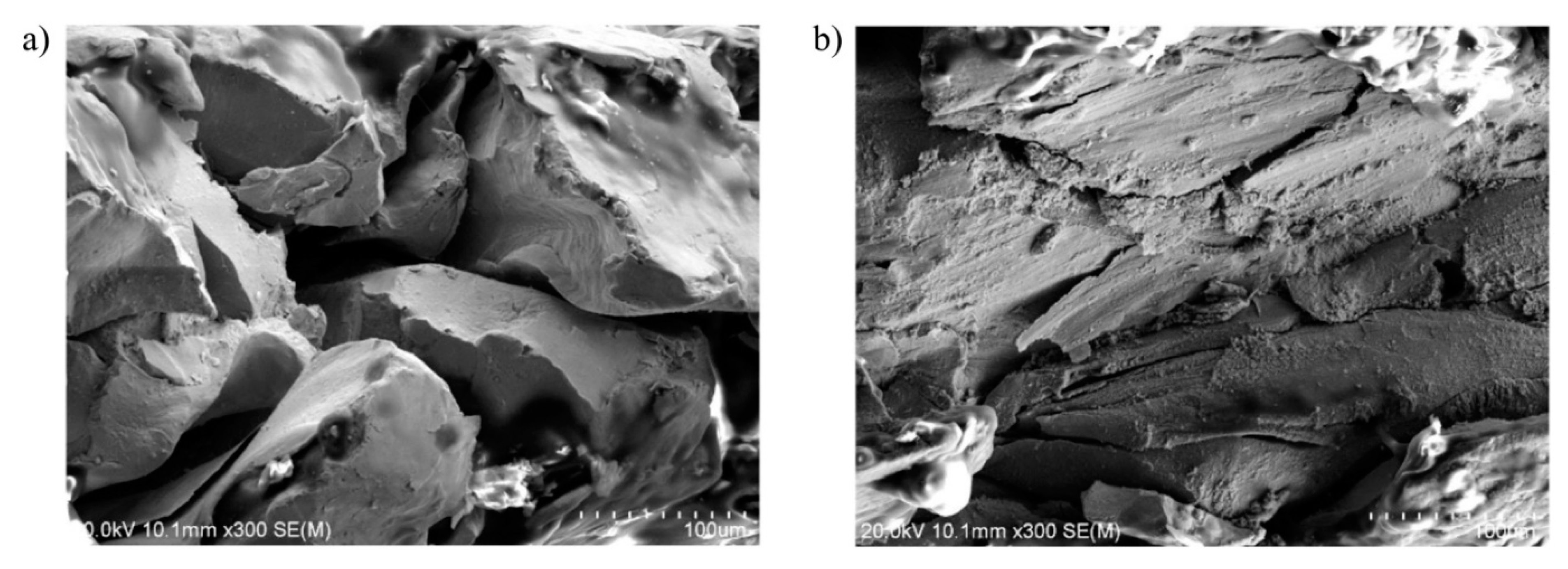
| Abbreviation | Mo% | Contents of Impurity Elements | |||
|---|---|---|---|---|---|
| Al | Si | C | O | ||
| Mo-L | 2 | 10 | 20 | 22 | |
| Mo-H | 2 | 10 | 20 | 22 | |
| Mo-C | 3 | 14 | 25 | 28 | |
| Material | Mo-L | Mo-H | Mo-C | ||||
|---|---|---|---|---|---|---|---|
| Test | Temperature | Strain Rate | Yield Strength | Strain Rate | Yield Strength | Strain Rate | Yield Strength |
| Test 1 | 297 K | 0.0001 | 411 MPa | 0.0003 | 498 MPa | 0.0003 | 599 MPa |
| Test 2 | 297 K | \ | \ | 0.003 | 577 MPa | 0.003 | 665 MPa |
| Test 3 | 297 K | 0.01 | 629 MPa | 0.03 | 725 MPa | 0.03 | 825 MPa |
| Test 4 | 297 K | 5378 | 1135 MPa | 6000 | 1149 MPa | 6200 | 1267 MPa |
| Material | Mo-L | Mo-H | Mo-C | ||||
|---|---|---|---|---|---|---|---|
| Test | Temperature | Strain Rate | Yield Strength | Strain Rate | Yield Strength | Strain Rate | Yield Strength |
| Test 1 | 273 K | 1151 | 942 MPa | 6000 | 1170 MPa | 6200 | 1260 MPa |
| Test 2 | 473 K | 3700 | 764 MPa | 3655 | 826 MPa | 3500 | 866 MPa |
| Test 3 | 673 K | 8500 | 624 MPa | 5802 | 709 MPa | 3600 | 721 MPa |
| Test 4 | 873 K | 3000 | 521 MPa | 7100 | 620 MPa | 6200 | 630 MPa |
| Test 5 | 1073 K | 7499 | 427 MPa | 3100 | 494 MPa | 3300 | 484 MPa |
| Test 6 | 1273 K | 3500 | 354 MPa | 3100 | 428 MPa | 3000 | 422 MPa |
| n | m | ||||||
|---|---|---|---|---|---|---|---|
| Mo-L | 4.25E8 | 3.98E8 | 0.60 | 1 | 0.0946 | 1.060 | 0.441 |
| Mo-H | 4.66E8 | 1.76E8 | 0.45 | 1 | 0.0826 | 0.990 | 0.482 |
| Mo-C | 5.59E8 | 2.23E8 | 0.51 | 1 | 0.0712 | 1.029 | 0.453 |
Publisher’s Note: MDPI stays neutral with regard to jurisdictional claims in published maps and institutional affiliations. |
© 2021 by the authors. Licensee MDPI, Basel, Switzerland. This article is an open access article distributed under the terms and conditions of the Creative Commons Attribution (CC BY) license (https://creativecommons.org/licenses/by/4.0/).
Share and Cite
Chen, S.; Li, W.-B.; Wang, X.-M.; Yao, W.-J.; Song, J.-P.; Jiang, X.-C.; Yan, B.-Y. Comparative Study of the Dynamic Deformation of Pure Molybdenum at High Strain Rates and High Temperatures. Materials 2021, 14, 4847. https://doi.org/10.3390/ma14174847
Chen S, Li W-B, Wang X-M, Yao W-J, Song J-P, Jiang X-C, Yan B-Y. Comparative Study of the Dynamic Deformation of Pure Molybdenum at High Strain Rates and High Temperatures. Materials. 2021; 14(17):4847. https://doi.org/10.3390/ma14174847
Chicago/Turabian StyleChen, Shuai, Wen-Bin Li, Xiao-Ming Wang, Wen-Jin Yao, Jiu-Peng Song, Xiang-Cao Jiang, and Bin-You Yan. 2021. "Comparative Study of the Dynamic Deformation of Pure Molybdenum at High Strain Rates and High Temperatures" Materials 14, no. 17: 4847. https://doi.org/10.3390/ma14174847
APA StyleChen, S., Li, W.-B., Wang, X.-M., Yao, W.-J., Song, J.-P., Jiang, X.-C., & Yan, B.-Y. (2021). Comparative Study of the Dynamic Deformation of Pure Molybdenum at High Strain Rates and High Temperatures. Materials, 14(17), 4847. https://doi.org/10.3390/ma14174847






